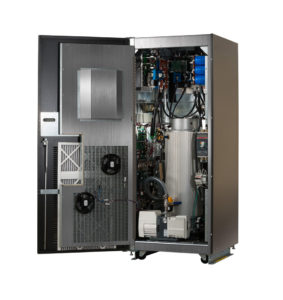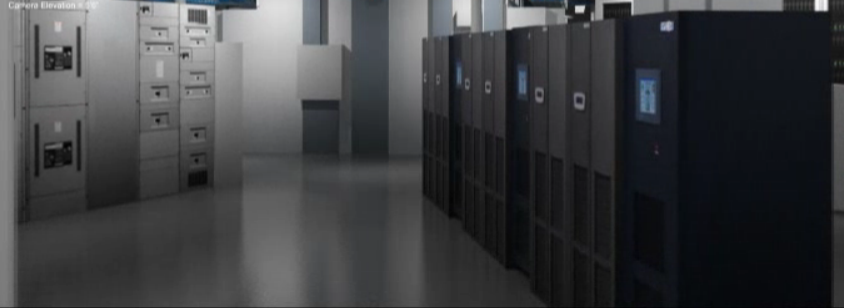 When OHSU added a new unmanned or “lights-out” data center in Hillsboro, Oregon, it took a novel approach with the building, infrastructure, cooling and critical electrical equipment that powers everything. Housed in an 18,000 square-foot geodesic aluminum dome, known as Data Center West, it significantly reduces energy and maintenance costs while assuring the highest possible levels of security and uptime. The Tier 3-Plus modular and scalable 3.8 megawatt (MW) data center (at final build-out) will accommodate more than 8,000 IT rack units in a hub-and-spoke configuration with an innovative design for ambient air cooling. In addition to highly efficient and reliable climate control, the novel monolithic aluminum geodesic dome delivers air filtration, seismic stability and load-bearing capacity for the facility.
When OHSU added a new unmanned or “lights-out” data center in Hillsboro, Oregon, it took a novel approach with the building, infrastructure, cooling and critical electrical equipment that powers everything. Housed in an 18,000 square-foot geodesic aluminum dome, known as Data Center West, it significantly reduces energy and maintenance costs while assuring the highest possible levels of security and uptime. The Tier 3-Plus modular and scalable 3.8 megawatt (MW) data center (at final build-out) will accommodate more than 8,000 IT rack units in a hub-and-spoke configuration with an innovative design for ambient air cooling. In addition to highly efficient and reliable climate control, the novel monolithic aluminum geodesic dome delivers air filtration, seismic stability and load-bearing capacity for the facility.
An Efficient Approach to Cooling
At the very top of the dome is a cupola that serves as a hot air exhaust port that can handle 750,000 cubic feet of air flow. There is also a vegetative bio swell around the base of the dome to provide additional air cleansing and cooling of the fresh air intake. Outside air of up to 80°F is drawn through louvers at the perimeter of the dome, and passes through a filter wall where it is presented to the face of the equipment racks by highly redundant supply fan walls. Leveraging the horsepower of the internal equipment fans, the air is discharged out the back of the equipment racks and carried out to the top of the pods by thermal buoyancy. Hot air then rises under the dome and is discharged through the cupola vent louvres. During cooler months, external air intake louvres are closed and recirculating louvres are open to the ceiling above the fans to prevent hot air contained within the dome from being drawn into the supply fans. This air is mixed with an appropriate amount of outside air to maintain the heating set-point for the facility. Recycling the hot equipment discharge air is a highly efficient way of heating the building.
“There’s really no need for backup batteries as the flywheels quickly and seamlessly transfer to our generators.”
The data center is designed with modular pods in a radial configuration, which are isolated from each other. The internal transformers, switchgear and UPSs are housed at the core of the data center and outside of the modular pods. Electrical distribution equipment and 1.25 MW standby generators are in the adjacent electrical yard.
Clean, Independent Power
“We have two independent power busways that are 100 percent autonomous,” explained Kerry Walker, Associate Director, OHSU Facilities Design and Operations. “At the rack level, each rack is plugged into each independent power system. All of the equipment in the racks have redundant power supplies plugged into the A and B power feeds with the DC outputs running in parallel. This eliminates any need to synchronize generators as the redundant power supplies are supplying DC to the equipment. By using two independent busways – an A/B configuration – I can turn off the power on system A to the data center and not affect anything else in the data center. Whereas with a parallel arrangement, it’s hard to turn things off during maintenance.”
When choosing a power protection solution, Walker knew he had to find backup power systems that had a small footprint, were reliable, highly energy-efficient and required minimal maintenance. Moreover, since the aluminum dome structure has no fire suppression, a battery-free UPS was essential. Walker added, “When lead-acid batteries start to go bad, they can catch fire.” This led him to pair 3-phase double-conversion UPSs with VYCON® VDC® flywheel systems.
 “I was familiar with flywheel systems from other large manufacturers; however, replacement of bearings every 3 to 4 years was not acceptable. We chose the VYCON VDC units due to their high-performance magnetic bearings which require no replacement or maintenance,” noted Walker. Replacement of bearings can cost upwards to $10,000 every three to four years.
“I was familiar with flywheel systems from other large manufacturers; however, replacement of bearings every 3 to 4 years was not acceptable. We chose the VYCON VDC units due to their high-performance magnetic bearings which require no replacement or maintenance,” noted Walker. Replacement of bearings can cost upwards to $10,000 every three to four years.
At Data Center West, there are dual 1MW UPSs with three VDC flywheel units each and two 100KW UPSs, each paired with a VDC flywheel system for facility loads, including interior lighting, access control panels and other key facility functions. Once there is a power outage, the VDC units quickly transfer the power load to the data center’s 1.25MW generators.
“There’s really no need for backup batteries as the flywheels quickly and seamlessly transfer to our generators. If the gen-sets are maintained properly, there’s no need for 15 minutes of battery backup time,” said Walker.
Environmentally Friendly Energy Storage
The VYCON VDC flywheel systems store and deliver a continuous source of DC power utilizing the kinetic energy of a high-speed flywheel. Compatible with all major brands of three-phase UPSs, the systems interface with the DC bus of the UPS, just like a bank of batteries, receiving charging current from the UPS and providing DC current to the UPS inverter during discharge.
The VYCON VDC stores kinetic energy in a dual-mode high-speed motor generator via a flywheel that spins 24/7 on standby charge until called upon to release that energy. Only the VDC operates with a permanent magnetic motor with 100 percent active bearings that deliver higher efficiency, zero bearing maintenance and a 20-year life span.
Another key advantage is the flywheel units’ small footprint and minimized maintenance requirements compared to batteries. A battery plant is approximately three times the size of a comparably sized flywheel, and they are the number-one cause of data center downtime. Compared to toxic lead-acid batteries, the VDC flywheel saves hundreds of thousands of dollars in operating expenses over 20 years.
In the future, Walker plans to add two more flywheels, one to each of the IT loads as well as add another power bus to the flywheel. “We’re on track to achieve the best Power Usage Effectiveness (PUE) in the industry without the use of internal air conditioners, humidifiers, air ducts, heaters or exhaust fans. Our very low carbon footprint gives us a data center that we’re very proud of,” said Walker.

